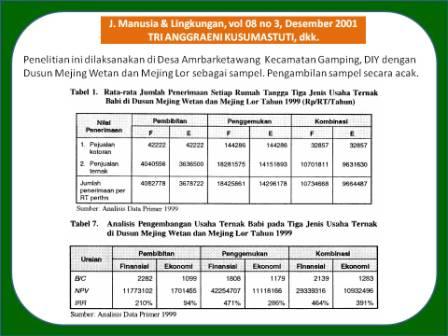
ANALISIS MANFAAT BIAYA LINGKUNGAN USAHA TERNAK BABI: STUDI KASUS DI DESA AMBARKETAWANG KECAMATAN GAMPING KABUPATEN SLEMAN (Benefit Cost Analysis of Pig Farming Environment: Case Study at Ambarketawang Village, Gamping District, Sleman Regency, Indonesia)
Tri Anggraeni Kusumastuti(1*), Irham Irham(2)
(1) Fakultas Pertanian Universitas Gadjah Mada Yogyakarta
(2) Fakultas Peternakan Universitas Gadjah Mada Yogyakarta
(*) Corresponding Author
Abstract
ABSTRAK
Penelitian ini bertujuan untuk mengetahui pendapatan peternak dan kelayakan pengembangan usaha ternak babi secara finansial maupun ekonomi. Penelitian dilakukan di Kecamatan Gamping. Data yang digunakan adalah data primer dari responden peternak dan data sekunder dari instansi terkait. Analisis yang digunakan adalah analisis pendapatan metode R/C Ratio, NPV (Net Present Value), dan IRR (Internal Rate of Return) dengan umur ekonomis kandang selama 3 tahun. Hasil penelitian menunjukkan bahwa analisis pendapatan secara finansial menghasilkan nilai lebih tinggi dibandingkan penilaian secara ekonomi. Jenis penggemukan memberikanpendapatan tertinggi secara finansial, sedangkan secaraekonomi, dengan memperhitungkan lingkungan, jenis kombinasi memberikan pendapatan tertinggi. Analisis sensitivitas menunjukkan bahwa penurunan harga babi berpengaruh terhadap penurunan pendapatan peternak dibandingkan peningkatan harga pakan dan peningkatan biaya lingkungan. Jenis pembibitan paling peka terhadap analisis sensitivitas, sedangkan jenis kombinasi penggemukan dan pembibitan tidak begitu terpengaruhi.
ABSTRACT
The objectives of this research were to assess the farmer’s income and the feasibility of pig farming, financially as well as economically. The data used in this research were primary data from pig farmers and secondary data from relevant institution. Financial and economic analysis of income and feasibility study with NPV (Net Present Value), B/C ratio, IRR (Internal Rate of Return) with economic barn value of 3 years, were applied in this research. The results showed that financially the fattening system gave the highest income, but the combination system was more efficient because it provided the highest income, but the combination system was more efficient because it provided the highest income, inspite of taking into consideration the environment effect. Sensitivity analysis showed that the pig price’s decline influenced the farmer’s income, more than the increased of feed price and environment cost. The breeding farm was the most affected by sensitivity analysis, but the combination farm wasn’t influenced by sensitivity analysis than (fattening and breeding system).
Full Text:
Artikel lengkap (PDF) (Bahasa Indonesia)Article Metrics
Refbacks
- There are currently no refbacks.
Copyright (c) 2017 Jurnal Manusia dan Lingkungan







